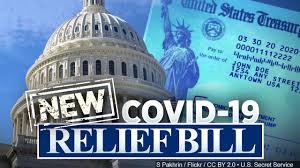
On March 12, 2021, President Biden signed the third COVID-19 related relief bill, the American Rescue Plan. Most Americans will benefit in one way or another from this bill. Let’s unpack what it may mean to you.
Stimulus Payments
- Individuals earning less than $75,000 and couples with income less than $150,000 will receive $1400 per person in direct payments.
- For example, a married couple with two children who have an adjusted gross income below $150,000 will receive a stimulus payment of $5,600.
- Each dependent claimed on your tax return will also receive $1400.
- Different in this relief bill, high school students age 17 and older, college students who are claimed as a dependent on someone else’s taxes, elderly adults claimed as dependents and disabled adults claimed as dependent are eligible for payments-however this payment goes directly to the taxpayer that claims the dependent.
- Payments are based on your 2020 tax return if you have already filed. Otherwise, they will be based on your 2019 tax returns.
- Individuals earning between $75,001 and $80,000 and couples earning $150,001-$160,000 will still receive a payment, however, the amount is adjusted based on their income.
- Individuals who earned over $80,000 and couples who earned over $160,000 will not receive stimulus payments.
Unemployment Compensation
- The bill extends additional federal unemployment benefits.
- Eligible recipients will receive an extra $300 per week through $600 per week. This is in addition to state benefits that are paid under state unemployment insurance programs.
- The first $10,200 in unemployment payments will be untaxable for households with less than $150,000 in income. This applies to the 2021 tax year.
Child Tax Credits
- The bill temporarily expands the child tax credit to $3000 for each child between the ages of 6-17 and $3600 for children under age 6. This applies to couples who earn less than $150,000.
- The credit is adjusted for households with incomes greater than $150,000.
- Families who are eligible for the full tax credit will also receive $300 payment per child per month from July through the end of the year.
Impact on Healthcare
- The bill also includes $7.5 billion to track, distribute and give COVID-19 vaccines, $46 billion towards diagnosis and tracing COVID infections, and $2 billion for testing supplies and PPE (masks, gloves, etc.).
- The bill also extends ACA (“Obamacare”) subsidies to higher-income individuals. As a result, more folks will be eligible for lower-cost premiums.
- ACA subsidies are also increased for lower-income individuals.
- Premiums are capped at 8.5% of income.
- For example, if you make $40,000 per year, your maximum healthcare premium through the ACA would be $3400/year or roughly $283 per month. This represents a large savings in premium costs for middle-income earners who did not previously qualify for the subsidy.
- Individuals who earn less than 150% of the Federal Poverty Limit (FPL) would pay no premiums for their health insurance.
- Individuals who earn unemployment compensation will also be eligible for subsidies and this income will be “treated” as no higher than 133% of the FPL. This means that folks who have lost their jobs and are receiving unemployment could purchase plans through the Marketplace with $0 premiums. However, there is a hiccup—if someone in your household has access to employer-affiliated coverage, this does not apply. You would need to access coverage through that person’s employer plan.
COBRA Premium Subsidy
- From April-September 30, 2021, the bill will subsidize 100% of the cost of COBRA premiums. This subsidy does not count towards your gross income.
- Applies to those who are involuntarily terminated from their jobs or who have a reduction in work hours within the last 18 months (on/after 11/1/2019).
- If you lost your job or had hours reduced and were offered COBRA coverage but declined, you will have 60 days after you receive a NEW notice to elect coverage to opt-in and receive the 6-month subsidy. This would NOT offer retro coverage for any period of time you did not have coverage.
- Those currently on COBRA will be eligible for 100% subsidy for up to 6 months (through 9/30/2021).
- Does not apply to individuals who have access to other group health coverage or Medicare.
- There is no income cap for this subsidy.
- This does not impact the length of time you can receive COBRA benefits. Learn more here about COBRA.
The Bill Also Provides
- $7.25 billion in small business loan programs, also known as PPP.
- $128 billion to educational institutions.
- $4.5 billion for Low Income Home Energy Assistance Programs (LIHEAP).
- $1.4 billion for nutrition, community programs, and caregiver support for programs already in place under the Older Americans Act.
- $25 billion for emergency rental assistance and,
- Increases the supplemental nutritional program for Women, Infants and Children (WIC).
As we start to emerge from the Pandemic, the provisions of the American Rescue Act will help us get back on our collective feet and recover. I know we are all looking forward to life after COVID—and hopefully, this will help guide us.
Christina is a clinical oncology social worker and the psychosocial content editor at OncoLink. Christina blogs about resources available to the cancer community, as well as general information about coping with cancer practically, emotionally, and spiritually. Christina is also an instructor at the Penn School of Social Policy and Practice. In her spare time, she loves to knit and volunteer with her therapy dogs, Linus and Huckleberry. She also loves to travel, cook and is an avid Philly sports fan.
One thought on “The American Rescue Act: What You Need to Know”